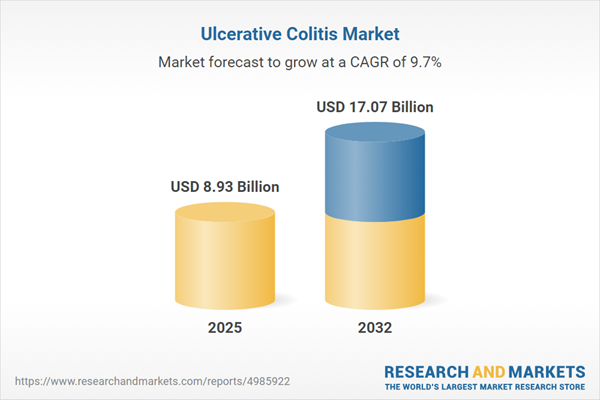Speak directly to the analyst to clarify any post sales queries you may have.
The ulcerative colitis market is in a period of rapid transformation, shaped by novel treatment modalities, evolving patient demands, and shifting reimbursement structures. Senior decision-makers require a comprehensive, actionable understanding of the landscape as healthcare ecosystems adapt to emerging trends and operational challenges.
Market Snapshot: Ulcerative Colitis Market Growth and Outlook
The ulcerative colitis market grew from USD 8.14 billion in 2024 to USD 8.93 billion in 2025 and is projected to accelerate at a CAGR of 9.68%, reaching USD 17.07 billion by 2032. This growth reflects the continued expansion of biologics, targeted therapies, digital integration, and evolving patient engagement strategies within the sector.
Scope & Segmentation
This report delivers a rigorous breakdown of the ulcerative colitis market, emphasizing critical therapeutic, channel, and geographic perspectives.
- Therapy Type: Aminosalicylates, Biologics, Anti Integrins, IL Inhibitors, TNF Inhibitors, Corticosteroids, Immunomodulators, Small Molecule Drugs
- Distribution Channel: Hospital Pharmacy, Online Pharmacy, Retail Pharmacy
- Route of Administration: Injectable, Intravenous, Subcutaneous, Oral
- Line Of Therapy: First Line, Second Line, Third Line And Beyond
- Patient Type: Adult, Pediatric
- Disease Severity: Mild, Moderate, Severe
- Regional Coverage: Americas (United States, Canada, Mexico, Brazil, Argentina, Chile, Colombia, Peru), Europe, Middle East & Africa (United Kingdom, Germany, France, Russia, Italy, Spain, Netherlands, Sweden, Poland, Switzerland, United Arab Emirates, Saudi Arabia, Qatar, Turkey, Israel, South Africa, Nigeria, Egypt, Kenya), Asia-Pacific (China, India, Japan, Australia, South Korea, Indonesia, Thailand, Malaysia, Singapore, Taiwan)
- Company Coverage: AbbVie Inc., Janssen Biotech, Inc., Takeda Pharmaceutical Company Limited, Pfizer Inc., Celltrion, Inc., Samsung Bioepis Co., Ltd., Sandoz International GmbH, Fresenius Kabi AG, Viatris Inc., Apotex Inc.
Key Takeaways for Senior Stakeholders
- Continued innovation in biologics and small molecules is expanding treatment options for moderate to severe cases and fostering more personalized care pathways.
- Digital health platforms and remote monitoring systems are beginning to drive real-world data integration, supporting improved adherence and risk prediction.
- Biopharmaceutical companies are leveraging partnerships, mergers, and acquisitions to strengthen product pipelines and integrate digital solutions into care delivery.
- Distribution models are diversifying as retail and online pharmacy channels gain relevance, enhancing patient access to subcutaneous injectables and oral therapies outside of traditional hospital settings.
- Pediatric populations and patients with differing disease severities are increasingly targeted for tailored research and interventions, enabling improved outcomes across demographics.
- Regional market drivers, including regulatory policies and healthcare funding models, are influencing product adoption, biosimilar uptake, and manufacturing localization strategies.
Tariff Impact: Navigating Supply Chain and Pricing Challenges
United States tariff measures implemented in 2025 have disrupted the active pharmaceutical ingredient supply chain, leading to higher costs for certain drug classes and prompting industry players to reassess supplier contracts and sourcing strategies. Manufacturers are adopting localized production and regional manufacturing agreements to reduce tariff exposure and ensure continuity of specialty therapies. Biosimilar development has accelerated as healthcare systems prioritize cost-effective options, resulting in a dynamic shift in procurement and pricing strategies throughout the ecosystem.
Research Methodology & Data Sources
This analysis utilizes a structured, multimodal research framework combining primary interviews with gastroenterologists, pharmacy directors, payers, and patient advocates with robust secondary research from peer-reviewed literature, regulatory filings, and clinical trial data. Triangulation and expert validation ensure accuracy and minimize bias throughout the research process.
Why This Report Matters
- Helps executive leaders benchmark strategic decisions by providing nuanced insights into segmentation, technology trends, and regional drivers.
- Enables operational resilience by detailing tariff impacts, manufacturing strategies, and channel diversification techniques relevant for ongoing risk management.
- Empowers stakeholders to align their innovation roadmaps and partnership models with proven approaches to patient engagement and market access.
Conclusion
The ulcerative colitis market is evolving rapidly through innovation, technology adoption, and operational adaptation. Organizations applying strategic insights and agile execution are best positioned to drive positive outcomes and capture growth opportunities within this dynamic therapeutic area.
Additional Product Information:
- Purchase of this report includes 1 year online access with quarterly updates.
- This report can be updated on request. Please contact our Customer Experience team using the Ask a Question widget on our website.
Table of Contents
3. Executive Summary
4. Market Overview
7. Cumulative Impact of Artificial Intelligence 2025
Companies Mentioned
The companies profiled in this Ulcerative Colitis market report include:- AbbVie Inc.
- Janssen Biotech, Inc.
- Takeda Pharmaceutical Company Limited
- Pfizer Inc.
- Celltrion, Inc.
- Samsung Bioepis Co., Ltd.
- Sandoz International GmbH
- Fresenius Kabi AG
- Viatris Inc.
- Apotex Inc.
Table Information
| Report Attribute | Details |
|---|---|
| No. of Pages | 180 |
| Published | November 2025 |
| Forecast Period | 2025 - 2032 |
| Estimated Market Value ( USD | $ 8.93 Billion |
| Forecasted Market Value ( USD | $ 17.07 Billion |
| Compound Annual Growth Rate | 9.6% |
| Regions Covered | Global |
| No. of Companies Mentioned | 11 |









